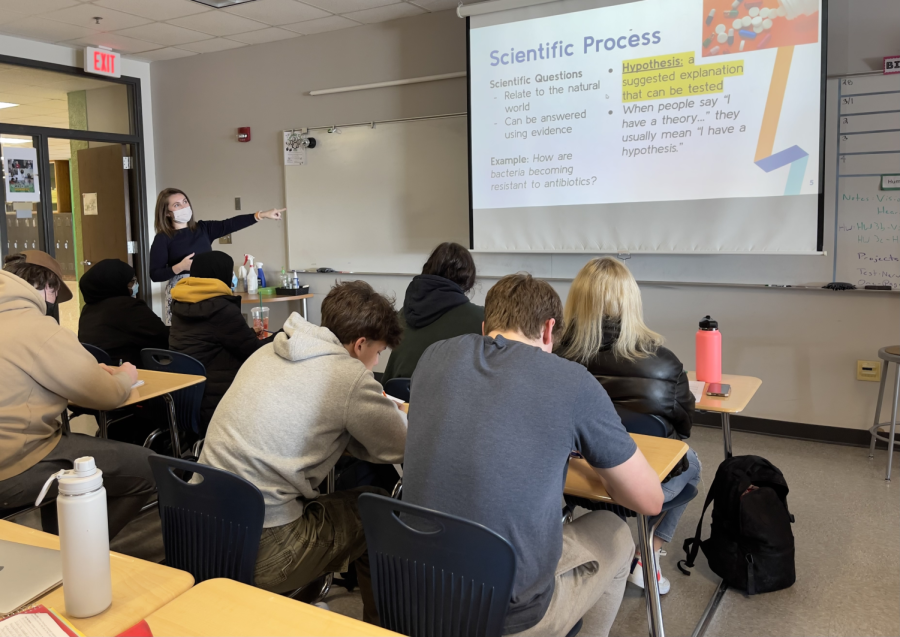‘It’s not for the faint-hearted’: Teaching during the COVID-19 pandemic
Students learn in a classroom with masks during COVID-19 pandemic.
March 30, 2022
From switches between learning styles to changes in school curriculum, teachers have faced the brunt of COVID’s uncertainty. Although the more traditional school year was uprooted as the pandemic began, recent challenges haven’t stemmed from COVID-19 itself, but its social and political implications.
While the sudden switch to distance learning was a difficult adjustment for teachers and students alike, some were quickly able to find methods that worked.
“I felt relatively prepared for a switch to distance learning as prior to the pandemic, I had created videos for lessons in AP Statistics and Advanced Algebra,” EHS teacher David Boone said. “Students would choose when they needed to be in the classroom for face-to-face instruction and when they could work independently. This worked for students with high motivation and follow-through.”
Edina’s 2021 AP Statistics exam scores were the highest they’ve ever been, which could correlate to the new teaching style.
However, the high grades didn’t come without downsides for teachers. Educating through a screen makes it difficult to motivate students without the help of an in-person learning environment. “Yes, we may have tried to create breakout rooms for group work, but that proved difficult as in-person just proved to be better for interpersonal interactions,” Boone said.
Although teachers can all agree that the return to in-person learning and the ability to interact with students again has been much better than previous distance- and hybrid-learning models, problems from the pandemic have still persisted through this school year. COVID-19 still exists and is highly contagious: even with masking and vaccination, it is possible to contract the virus, causing many students to take time off school to recover and prevent further spreading if they tested positive.
“This year with isolations and quarantining, it has proven to be a nightmare in staying organized with having students in and out of class for longer periods of time and working with students to create plans for make-up work,” Boone said. “There are more students on different pathways at different times working towards the same goal, and this can be exhausting.”
Teachers have been collaborating more often and more strongly with the Edina School Board with the transition back to in-person this school year. With 95% of Edina Public Schools educators being members of the teachers’ union, they play an important role in making district decisions. The main issues facing Edina schools—besides preventing COVID-19 outbreaks—are staff shortages and students’ mental health.
“These [problems] existed pre-pandemic, but were exacerbated by the pandemic,” said Jason Dockter, the head of the Edina chapter of Education Minnesota teachers’ union. “There is no silver bullet solution to these challenges. It will take collaboration not only between the union and the district, but we will likely need the state and federal governments to be partners in these areas as well.”
Though COVID-19 cases and precautionary isolation played a significant role in the shortages of teachers and support staff, the retirement of teachers was also a factor—and spells worry for the future, perhaps even after the pandemic is over.
Dr. Jehanne Beaton, a professor at the College of Education and Human Development at the University of Minnesota, teaches aspiring undergraduate and graduate educators. Beaton experienced an increase of students entering her program at the beginning of the pandemic, so much so that she added a third section of her fall class. Since then, she has seen a 25% decrease in applicants to her program.
“My program has been growing since I took it over about five years ago. And this is the first year I’ve seen a drop in applicants,” Dr. Beaton said.
Beaton believes that the cause behind the decrease in applicants, which also occurred in the licensure program, is twofold.
“The conditions that teachers are working under right now is part of the puzzle. But very honestly, the whole critical race theory scandal that everybody seems to think is happening in schools all over the place, and the surveillance of teachers in terms of what they want to teach, what they teach—I think that’s been a deterrent,” Dr. Beaton said.
Beaton noted that the recent wave of legislation restricting classroom subject topics may also be contributing to a feeling of worry among aspiring teachers who won’t have tenure as they enter the workforce. Recently proposed laws such as the “Don’t Say Gay” bill in Florida go as far as to restrict what topics can be discussed in the classroom, whilst others, such as Indiana House Bill 1134, would require teachers to publicly submit their teaching materials up to a year in advance.
“I think it’s meant to scare teachers more than anything and intimidate them into not talking about race and racism, sexual orientation, LGBTQ history, and women’s history,” Dr. Beaton said.
Teacher shortages are also a concern for Senator Mary Kunesh, who sits on the Minnesota Senate Education Finance and Policy Committee and is a former sixth-grade teacher and library media specialist.
“There’s not enough teachers now for the jobs that we have. And I think part of it is because teachers are expected to do more with less resources. I think that there is sort of this general disrespect for teachers and the educational system,” Kunesh said.
A new slate of bills proposed by Minnesota Senate Republicans known as the Parents’ Bill of Rights would mandate that teachers grant access to their curriculum to all parents within the first two weeks of the school year, among other policies. Proponents of the bills argue that they create transparency and allow parents to take a necessary role in the direction of students’ education.
Although Kunesh recognizes the importance of parents’ roles in their children’s education, she opposes the bill on the grounds that most teachers already have their curriculum easily accessible with the prevalence of online platforms such as Schoology. Critics of laws such as the Parents’ Bill of Rights have also noted that, as unfunded mandates, the personnel and time needed to fulfill the laws could create an undue burden on schools.
“It’s insinuating that teachers and schools are not…engaging with the parents, like there isn’t a sense of trust and coordination and collaboration with parents and teachers. And that just isn’t my experience as a teacher of 25 years,” Kunesh said.
Another bill would create an “education savings account,” which would allow parents who send their children to private schools to use a student’s state-allocated education funding to pay the tuition.
“I feel like it’s sort of a way to undermine public education, to basically destroy public education, and undermine the authority of teachers’ unions. And it’s really not the kind of legislation that, right now, we should be focusing on,” Kunesh said.
As Beaton taught her students online last year, she began to integrate virtual methods of teaching alongside their in-person equivalents. But beyond educating solely on pandemic teaching methods, she also began emphasizing “strength and navigation skills,” or how to educate both in the context of a pandemic and in the current political climate.
“I think we’re looking for teachers who are tougher internally, who have stronger metal internally, so that they can withstand some of what they’re heading into. It’s not for the faint-hearted right now,” Dr. Beaton said.




